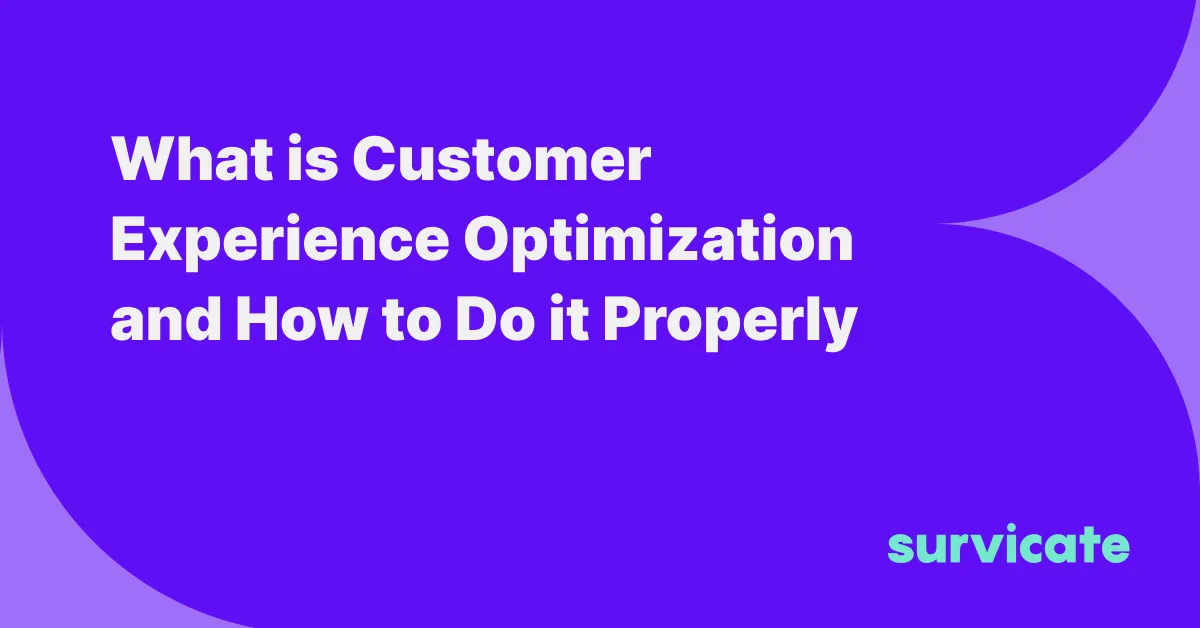Tl;dr;
- Investing in customer experience design enhances customer satisfaction and fosters an environment for increased sales, loyalty, and revenue by uncovering customer needs and addressing them in a structured way.
- Effective customer experience design principles prioritize meeting and exceeding customer expectations through a detailed customer journey map, clear goal setting, a customer-centric approach, cross-departmental collaboration, and maintaining a documented CX blueprint for consistency across the brand.
- Designing CX involves understanding the customer journey, empathizing with customers, identifying touchpoints, ensuring organizational buy-in, and using KPIs like CSAT and NPS for continuous improvement and innovation to exceed evolving customer expectations and industry standards

Creating a seamless customer experience is no small feat—it requires a deep dive into the customer journey, identifying every interaction they have with your brand.
This article is for business professionals who recognize the value of customer satisfaction and are seeking to foster loyalty and drive sales through effective customer experience design. We'll explore the key principles of crafting engaging user journeys, from understanding the needs to asking for customer feedback for continuous improvement.
By the end of this read, you'll understand how to create a consistent and rewarding experience for your customers, which is essential for building a thriving and sustainable business.
What is Customer Experience Design?
Customer Experience (CX) Design is your strategic approach to shaping every interaction between the customer and your brand, aiming to leave a positive, lasting impression at every stage of their journey.
CX design vs. UX design
While CX design focuses on the entire journey a customer has with your brand, UX design (user experience design) is specific to a user's interaction with a product or service. CX encompasses all contact points, from the initial awareness to post-purchase interactions, striving for customer delight and fostering loyalty. On the other hand, UX design zeroes in on the usability and function of individual products or features, affecting parts of the customer journey.
Align CX design with your brand
Your execution of CX design should align with your brand's values and identity—it's why you're investing in CX. Creating experiences that resonate with your customers at every touchpoint strengthens your brand relationship, translating into better customer satisfaction and brand loyalty. This alignment dictates how you address your customers' needs and sets the stage for every interaction they have with your brand.
Why CX design matters
Investing in customer experience design (CX) has tangible benefits that can significantly impact your business's bottom line. Understanding the merits of a solid CX design strategy can foster growth and ensure customer satisfaction.
Unveils customer touchpoints
By analyzing customer interactions, you can identify preferred channels and touchpoints. This insight helps you to deliver service and communication that aligns with their lifestyle and habits, enhancing their experience and satisfaction.
Increases customer loyalty
A positive customer experience is crucial for retention. Existing customers are more likely to repeat purchases if they're satisfied. It's also what turns sporadic shoppers into loyal customers. It's an important strategy to reduce churn and build a reliable customer base.
Aligns internal teams
A company-wide commitment to CX ensures that all teams are on the same page. From product development to sales, each team member understands their role in delivering quality experiences, ensuring a unified approach to customer satisfaction.
Reduces marketing costs
Happy customers are likely to share their experiences, effectively becoming brand advocates. This word-of-mouth can be a potent form of free marketing, simultaneously building trust and reducing the need for expensive advertising campaigns.
Increases revenue
Customers are willing to pay more when you deliver a superior customer experience. This can lead to increased revenue as consumers often prefer a better experience over a slightly lower-priced competitor.
Discovers customer needs
Engaging in CX design allows you to better understand what your customers truly want. This knowledge can help tailor your offerings to meet and exceed their expectations, making your products and services irreplaceable.
Increases sales
An exceptional customer experience can foster an environment conducive to upselling or cross-selling. When customers feel valued and understood, they are more open to recommendations, which can lead to additional sales opportunities.

Customer experience design principles
In customer experience design, focusing on strategies that meet and exceed customer expectations at every interaction with your brand is crucial.
Customer journey
Mapping the customer journey: You need to understand the path your customers take from first contact through various touchpoints until post-purchase engagement. This map should detail each step a customer takes, considering their physical and emotional experiences.
Goal Setting
Defining clear objectives: Set specific, measurable goals for your CX design, such as increasing repeat customer rates or reducing customer service issues. Your objectives should align with broader business goals, ensuring that every CX initiative contributes to your company's success.
A customer-centric element
Prioritizing customer needs: Your CX design must place the customer at the core. This means not only understanding but prioritizing their needs, preferences, and feedback. Every decision should enhance the customer's experience and satisfaction with your brand.
Cross-team collaboration
Engaging all departments: For a seamless CX, you need cross-departmental collaboration. Every team must work together to deliver a consistent and positive customer experience, whether it's sales, marketing, or customer support.
CX documentation
Maintaining a CX Blueprint: Document your CX strategies and guidelines detailing each aspect of customer experience. This blueprint ensures that everyone in your organization understands and can execute the CX vision consistently.
How to design a customer experience
Designing a customer experience (CX) requires an intricate understanding of the customer journey map and implementing strategies that cater to the needs and expectations at every customer's touchpoint. Below are structured steps to guide you through the CX design process.
Empathize with your customer personas
Empathy is key: Before you dive into the design, put yourself in your customers' shoes. Understand their motivations, pain points, and what they value in a service. Tailoring the CX starts with insight, often gathered from customer feedback, market research, and persona development.
Map the customer experience design
Mapping the customer experience is a critical step in your SaaS marketing strategy. Begin by outlining every stage of the customer journey, from initial awareness to post-purchase support. Identify key interactions, or touchpoints, that your customers have with your software. This includes free trial sign-ups, onboarding emails, customer service interactions, and upgrade opportunities.
➡️ Identify emotional touchpoints
Consider not just the physical steps but also the emotional journey. How do customers feel when they encounter your SaaS product? Pinpoint moments of frustration or delight in understanding where your CX design can be enhanced.
➡️ Collect customer feedback
Use customer feedback to refine your map. Listen to what users say about each touchpoint to tailor your approach. This feedback loop is integral to a SaaS marketing strategy that resonates with users and encourages long-term engagement.
Measure your efforts
In customer experience design, your success hinges on how well you can measure and enhance the user's journey. The strategic implementation of Key Performance Indicators (KPIs) and a Continuous Improvement Process are pivotal to this endeavor.
➡️ Customer experience KPIs
Your selection of KPIs should reflect the goals of your customer experience strategy. Examples of such indicators include Customer Satisfaction Score (CSAT), which gauges short-term happiness, or Net Promoter Score (NPS), assessing the likelihood of customers recommending your service. It's essential to track these metrics regularly to pinpoint areas in need of enhancement.
CSAT: Utilize surveys post-interaction to measure satisfaction.
NPS: Compile feedback to understand customer advocacy potential.
➡️ Continuous Improvement Process
Adopting a cycle of evaluation, optimization, and implementation ensures that customer experience design not only meets but exceeds user expectations. Analyze the data collected from your KPIs to identify patterns and areas for improvement. Test new strategies based on these insights and implement them to see continuous growth in customer satisfaction.
- Evaluate: Review KPI data to uncover customer experience trends.
- Optimize: Develop targeted strategies to address identified issues.
- Implement: Roll out improvements and monitor their impact on KPIs.
Organizational adoption
When you integrate Customer Experience (CX) Design into your organization, it is crucial to consider how it will be adopted across various departments and managed effectively through change.
➡️ Cross-departmental collaboration
Your organization must encourage collaboration between all departments to achieve a cohesive CX design. This integration involves sharing customer insights and coordinating efforts, ensuring that a unified strategy informs each touchpoint with the customer. McKinsey highlights that an effective redesign requires seamless cross-functional collaboration, featuring new ways of working, clear design principles, and processes aligned with your CX goals.
➡️ Change management
Implementing CX design is a significant change that necessitates effective management to succeed. Your leaders should clearly communicate the importance of customer experience and each employee's role in this vision. According to a Deloitte viewpoint, it includes setting up governance structures, defining roles and responsibilities, and ensuring the entire organization is aligned and prepared to deliver on the CX promise.
Check on your CX design often
Innovate and Iterate: The market and your CX design are evolving. Regularly update your CX strategy to incorporate new technologies, feedback, and market trends, ensuring you stay ahead of customer expectations and industry standards.
Design your customer experience with Survicate's surveys
As we wrap up our journey through the intricacies of Customer experience design, it's clear that the success of any SaaS marketing strategy hinges on truly understanding and meeting customer needs. The journey doesn't end with good intentions; it flourishes with the strategic application of customer insights. Survicate emerges as a valuable ally in this quest, with its powerful survey capabilities and in-depth analytics that offer a window into your customer's world.
Utilizing Survicate's customizable surveys and integrations can transform the way you connect with users, ensuring that every decision is informed by data-driven feedback. This isn't just about tracking metrics; it's about crafting experiences that resonate on a deeper level.
To see the impact that Survicate can have on your customer experience efforts, why not give it a try? Embark on a path to refined CX design—sign up for a 10-day free trial of Survicate's Business Plan, and confidently steer your strategy toward success.








.webp)


.webp)


.svg)

.svg)



